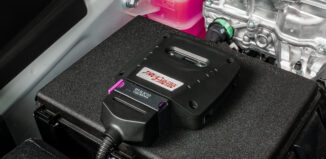The Infiniti VR30 twin turbo might be one of the most hotly debated and anticipated engine design in years. All the comments flying around the forums and blogs about a “cheap 600+ whp car” might make you wonder: is it wishful thinking, or an attainable goal?
For starters, the VR30 is not the same animal as the VG30 or a similar bulletproof iron block monsters of the 90’s. It’s also not a hand-built GTR motor already making 500+ hp. Still, it’s all conjecture, and up until now Infiniti hasn’t released enough information to help separate fact from fantasy.
You may recall a few months ago we looked at the new VR30 Twin Turbo motor from an aftermarket perspective based on the information given at the time (An Aftermarket perspective on the new Nissan/Infiniti VR 3.0 Twin Turbo V6). Recently Infiniti released some “Technical Cinemagraphs” offering a closer look at this new engine. These Cinemagraphs give us a lot more information about the motor design and what we might be able to improve upon.
Twin Turbos and Two Outputs
As we already know, the VR30 will be a 3.0-liter V6 Twin-Turbo Engine with two output variations: one producing 300hp and the other a whopping 400hp. We covered the differences in the last blog post, so armed with fresh information we can look at areas we feel might yield results.
Intake Manifold and Intercoolers
Starting at the top with the most obvious (however not the cheapest) potential upgrade: the intake manifold. As you can see, the design of the intake manifold looks ideal for “packaging”. Looking at the diagram below you can see some of the restriction points as well as areas that are susceptible to turbulence. While this will work fine and is great for a the stock setup, it leaves room for potential improvement.
Take a look at the Nissan GTR Intake Manifold Design below. A larger plenum (which the OEM design doesn’t really have) helps take care of air starvation issue before the boost fully kicks in. The shape of the plenum creates less turbulence and feeds more directly into the runners. With this type of manifold, the runner lengths could also be optimized for performance. Coupled with the possibility of switching from an Air to Water to an Air to Air Intercooler setup (which would free up the space on top of the motor), a GTR-esque Intake Manifold would potentially yield serious gains.

Intercooler Conundrum
We discussed an Air to Air Intercooler setup in the last article. There are potentially limitations to the factory intercoolers as they were designed for a specific amount of power and boost. Also, with an increase in boost the almost 90° turn the air has to make could create another restriction point. If we can fit a front mount Air to Air Intercooler it could allow for a safer increase in boost and squeeze a lot more juice out of this new 3 liter.
You might say: “But STILLEN, what about the turbo lag from the increased distance between the turbo and throttle body?” While greater distance between the turbo and throttle bodies can increase the time it takes for the pressure to build, the effect is so negligible it’s not worth worrying about. The real difficulty lies with fitting all the plumbing in. We know what the Q50 engine bay looks like and an Air to Air Intercooler setup will prove very challenging. We hope that the Q60 gives us a little more space to work with. If not it should still be possible to upgrade the pump and heat exchanger for the Air to Water Setup, and/or upgrade the intercoolers themselves. However, because of the space restrictions, upgrading the actual intercoolers may be difficult.
High Flow Intakes
The next power grab opportunity is the intakes (everything pre-turbo). A visual analysis of the OEM design reveals an air flow path that can definitely be smoothed out. Understanding that Nissan/Infiniti had the parameters of the EPA to follow and NVH (Noise, Vibration, and Harshness) standards to meet, we know why they went with this design. Fortunately for us this leaves some room for improvement.
The air coming through the air boxes is forced through the restrictive panel filter, then takes a hard 90° turn over the Mass Air Flow Sensor (MAF) which is not ideal because of turbulence created by this design. It then executes yet another 90° turn before reaching the turbos. Simply reducing the number of turns in the system and creating a smoother path for the air as it passes over the MAF will allow for more accurate readings (helpful in tuning) as well as less restriction. The restriction can also contribute to a significant power loss. On other modern turbo powerplants, we have observed notable power gains by simply adding a high flow intake which can increase the boost (boost can be limited by restrictions on the intake side of both Turbo’s and Superchargers).
Exhaust & Turbos
Exhaust system modifications on turbo cars always generate power gains. Down pipes and cat-backs are already a given for the VR30 and will be available from STILLEN. Now we finally got a look at the cylinder head to turbo interface so we can see what might be done about turbo upgrades.
Looking at the design of the turbo flange, it appears that fabricating an adapter for aftermarket turbos should be pretty simple. Though we don’t know specs on the turbos yet, it won’t be difficult to sort out good upgrade options for those looking to make a lot more power. The only limiting factor might be space, but most upgrades shouldn’t pose an issue.
We still need more information about the engine internals before we can be more specific about turbo upgrades and increased boost. However, most Nissan/Infiniti Motors tend to be pretty hearty. The old VG30’s were capable of 550-600 whp with a healthy block and the VQ37’s held up to about 500 whp on stock internals (with Turbo Kits). It seems fairly safe to assume we be able to get this motor close to the 500 whp mark without reliability issues. The 600 whp mark that everyone is hoping for might be a possibility, but it will depend on the strength of the internals.
We will be getting a few VR30 equipped test vehicles delivered to STILLEN in the next few months. We can’t wait to get our hands on them and start doing some real world testing. Stay tuned for more articles and info on the VR30 as we continue to learn more about this motor!
STILLEN combines best in class automotive parts and accessories with expert service to deliver personalized lifestyle solutions for automotive enthusiasts seeking power, performance and style.




The question of the day is what other platforms are getting this 3.0TT?? Do I hear QX70 Red Sport?
It is probably safe to assume most of the models that are VQ37 equipped will be getting this motor in the future.